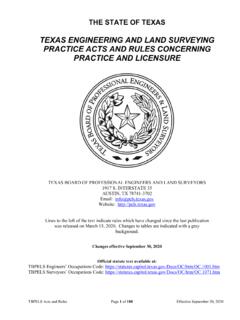Transcription of Random Processes for Engineers 1
1 Random Processes forEngineers1 Bruce HajekIllinois1 This is a preproduction copy of the text of the same title published by CambridgeUniversity Press, March 2015. book supercedes Notes for ECE 534: An Exploration of Random Processes forEngineers. Cambridge University Press has kindly allowed the author to make thisversion of the book freely available on his webpage. It does not incorporate final sets ofedits and corrections. Permission is hereby given to freely print and circulate copies ofthese notes so long as the notes are left intact and not reproduced for commercialpurposes.
2 Email to pointing out errors or hard to understandpassages or providing comments, is Beth, for her loving Selective Review of Basic axioms of probability and conditional variables and their of a Random of a Random used rate distributed Random Correlation and Transformation of Random vectors302 Convergence of a Sequence of Random definitions of convergence of Random criteria for convergence of Random theorems for sums of independent Random functions and Jensen s bound and large deviations theory623 Random Vectors and Minimum Mean Squared Error definitions and orthogonality principle for minimum mean
3 Square expectation and linear expectation as a of the Gaussian distribution and Gaussian Random innovations Kalman filtering96 Contentsv4 Random of a Random walks and gambler s with independent increments and Processes and the Poisson properties of Random independence and Markov Markov Space-time structure of discrete-state Markov processes1365 Inference for Markov bit of estimation expectation-maximization (EM) Markov state probabilities and the likely state sequence Viterbi Baum-Welch algorithm, or EM algorithm for of Countable-State Markov with finite state and convergence of discrete-time Markov and convergence of continuous-time Markov Processes of birth-death averages vs.
4 Statistical systems, M/M/1 queue and Little s arrival rate, distributions seen by arrivals, and examples of queueing systems modeled as Markov birth-death stability criterion and moment criteria for discrete-time criteria for continuous time processes2057 Basic Calculus of Random of Random square differentiation of Random of Random , Part Karhunen-Lo`eve WSS Random processes252viContents8 Random Processes in Linear Systems and Spectral transforms, transfer functions and power spectral Processes in linear Random Random , Part II2859 Wiener of the orthogonality causal Wiener filtering functions and spectral of the causal Wiener filtering problem for rational powerspectral time Wiener Conditional expectation Martingales with respect to Azuma-Hoeffding Stopping times and the optional sampling Some Convergence of sequences of Continuity of Derivatives of Riemann Lebesgue Riemann-Stieltjes Lebesgue-Stieltjes On convergence of the Matrices36012 Solutions to Even Numbered Problems365 References437
5 PrefaceFrom an applications viewpoint, the main reason to study the subject of thisbook is to help deal with the complexity of describing Random , time-varyingfunctions. A Random variable can be interpreted as the result of a single mea-surement. The distribution of a single Random variable is fairly simple to is completely specified by the cumulative distribution functionF(x), a func-tion of one variable. It is relatively easy to approximately represent a cumulativedistribution function on a computer. The joint distribution of several randomvariables is much more complex, for in general, it is described by a joint cumu-lative probability distribution function,F(x1,x2.)
6 ,xn), which is much morecomplicated thannfunctions of one variable. A Random process, for example amodel of time-varying fading in a communication channel, involves many, possi-bly infinitely many (one for each time instanttwithin an observation interval) Random variables. Woe the complexity!This book helps prepare the reader to understand and use the following meth-ods for dealing with the complexity of Random Processes : Work with moments, such as means and covariances. Use extensively Processes with special properties. Most notably, Gaussian pro-cesses are characterized entirely be means and covariances, Markov pro-cesses are characterized by one-step transition probabilities or transitionrates, and initial distributions.
7 Independent increment Processes are char-acterized by the distributions of single increments. Appeal to models or approximations based on limit theorems for reduced com-plexity descriptions, especially in connection with averages of independent,identically distributed Random variables. The law of large numbers tellsus, in a certain sense, a probability distribution can be characterized byits mean alone. The central limit theorem, similarly tells us a probabilitydistribution can be characterized by its mean and variance. These limit the-orems are analogous to, and in fact examples of, perhaps the most powerfultool ever discovered for dealing with the complexity of functions: Taylor stheorem, in which a function in a small interval can be approximated usingits value and a small number of derivatives at a single Diagonalize.
8 A change of coordinates reduces an arbitraryn-dimensional Gaus-sian vector into a Gaussian vector withnindependent coordinates. Inthe new coordinates the joint probability distribution is the product ofnone-dimensional distributions, representing a great reduction of complex-ity. Similarly, a Random process on an interval of time, is diagonalized bythe Karhunen-Lo`eve representation. A periodic Random process is diago-nalized by a Fourier series representation. Stationary Random Processes arediagonalized by Fourier transforms. Sample. A narrowband continuous time Random process can be exactly repre-sented by its samples taken with sampling rate twice the highest frequencyof the Random process.
9 The samples offer a reduced complexity represen-tation of the original process. Work with baseband equivalent. The range of frequencies in a typical wirelesstransmission is much smaller than the center frequency, or carrier frequency,of the transmission. The signal could be represented directly by sampling attwice the largest frequency component. However, the sampling frequency,and hence the complexity, can be dramatically reduced by sampling a base-band equivalent Random book was written for the first semester graduate course on Random pro-cesses, offered by the Department of Electrical and Computer Engineering atthe University of Illinois at Urbana-Champaign.
10 Students in the class are as-sumed to have had a previous course in probability, which is briefly reviewed inthe first chapter. Students are also expected to have some familiarity with realanalysis and elementary linear algebra, such as the notions of limits, definitionsof derivatives, Riemann integration, and diagonalization of symmetric topics are reviewed in the appendix. Finally, students are expected tohave some familiarity with transform methods and complex analysis, though theconcepts used are reviewed in the relevant chapter represents roughly two weeks of lectures, and includes homeworkproblems.














